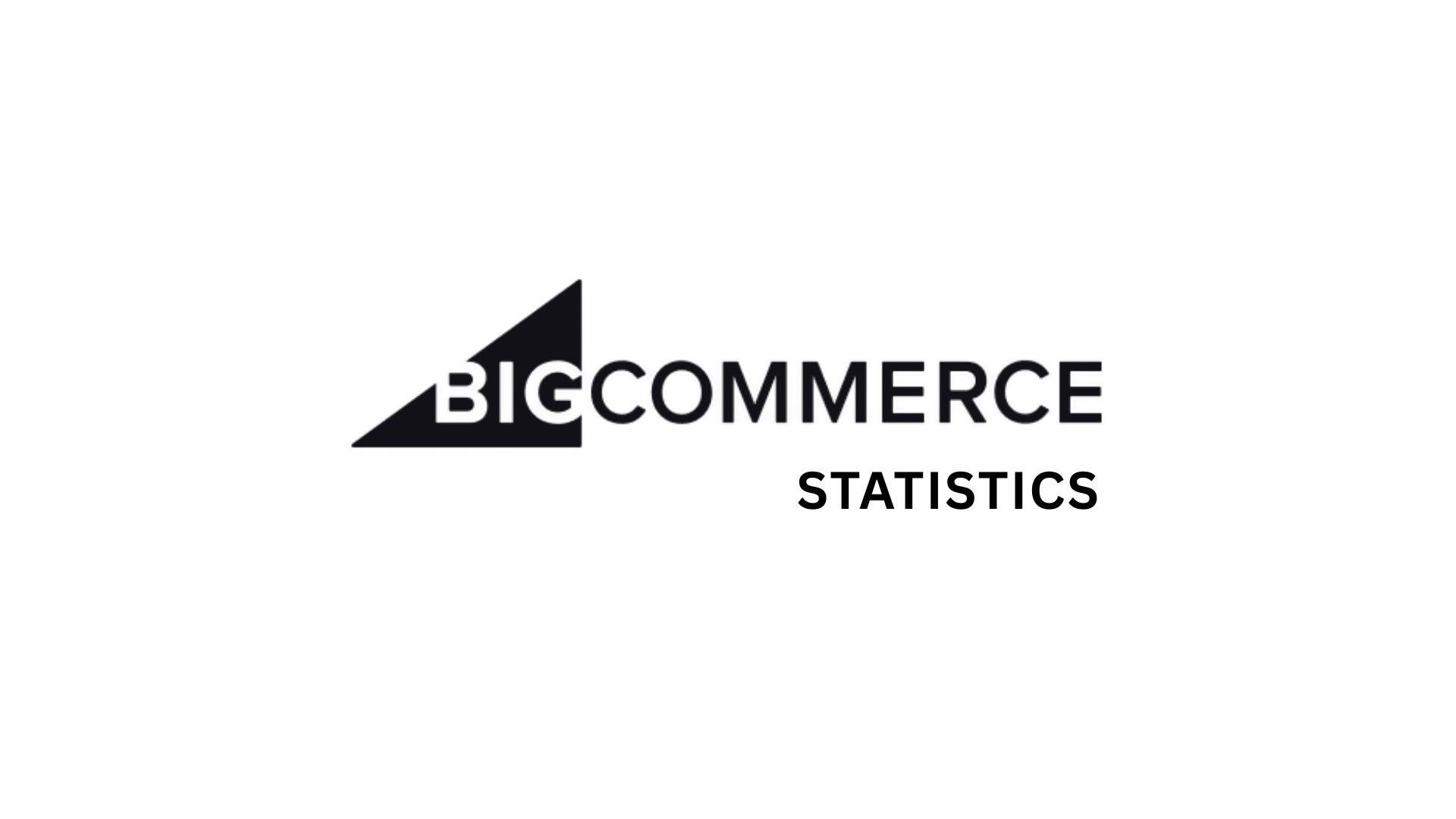Trello Statistics and Facts (2025)
Updated · Mar 27, 2025
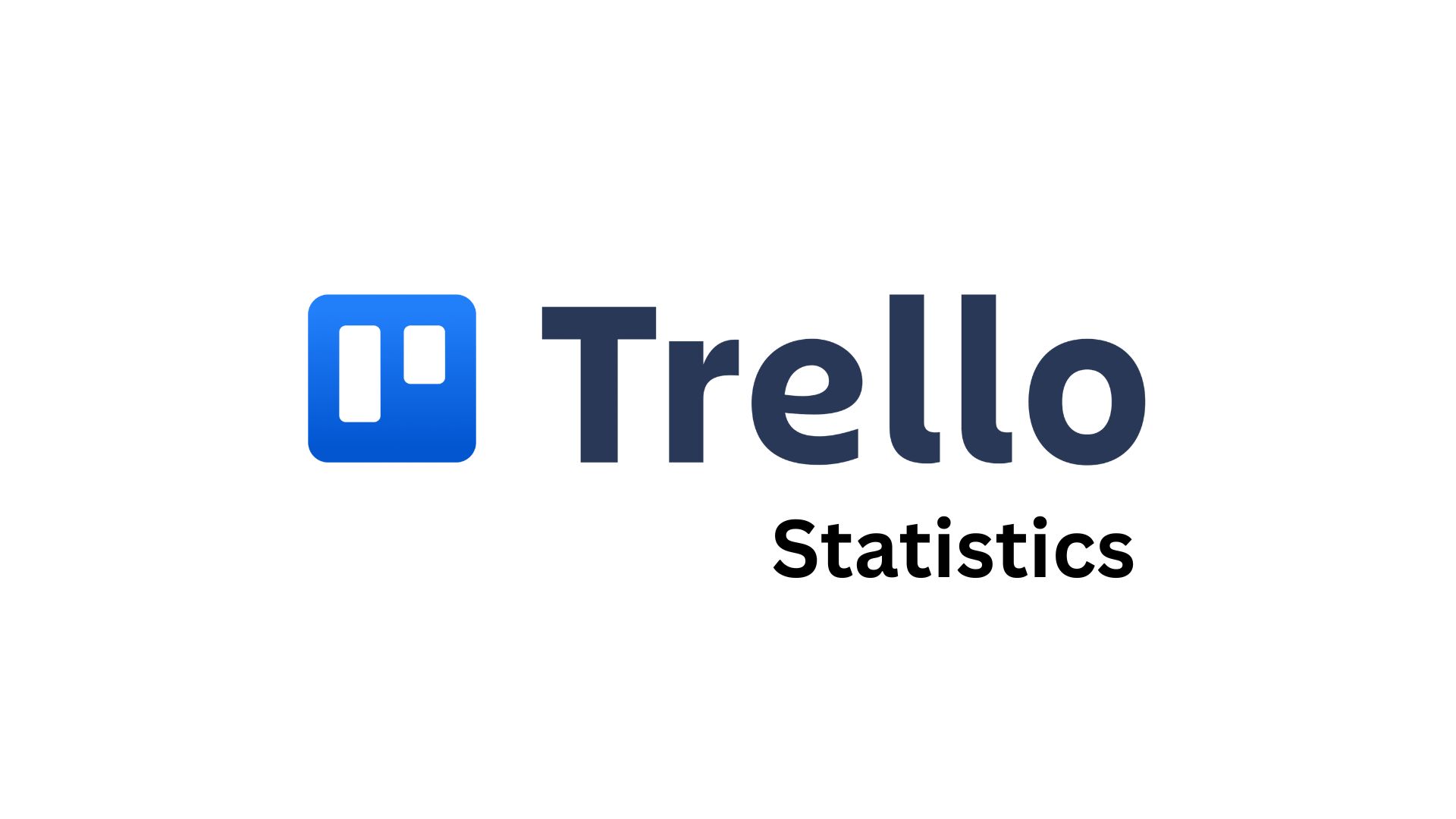
Table of Contents
Introduction
Trello Statistics: Trello, a well-known project management tool, is used broadly in organisations around the world. The growth trajectory and user engagement of Trello as of 2025 have offered insightful statistics on these, along with being able to speak of fact-checking, such as the productivity software market. These Trello statistics are explored in this article, along with a complete account of Trello’s 2024 performance.
Editor’s Choice
- Trello managed to grab a market slice of 4.8% in the Enterprise Resource Planning (ERP) software category, competing with platforms such as SAP ERP, Oracle NetSuite, and Microsoft Dynamics 365.
- Trello statistics show that Top on Information Technology Services is used by 7,251 companies, followed by Computer Software with 5,129 and marketing & advertising, which use 3,207 of such companies.
- The largest Trove user community is in the USA (20,195 companies). Next are the UK (3,876), Brazil (3,214), and France (2,403).
- The Trello web traffic registered 72.56 million visits in December 2024, rising to 76.75 million in January 2025. However, visits slightly dropped to 74.49 million in February 2025.
- Brazil leads in Trello website visits with 20.02%, although this declined by 2.76%. The United States, on the other hand, saw a 3.20% increase with 16.95%. Japan recorded the most significant drop at 5.12% with a total of 5.98%.
- Trello statistics reveal that Organic search’s share contributes 10.78% to the collection, while paid marketing is only at 1.40%.
- The site reveals that 54.52% of users are male, while 45.48% are female. The largest age group is 25 to 34, with 29.92% of users in this age group. 18-24 years of age comes next at 21.67%, followed by 35-44, which recorded 18.62%.
Key Facts
- Trello statistics state that it has around 90 employees. Although Trello is a rather small entity, it is today a popular project management tool. It is owned by Atlassian, which, in an interesting acquisition, acquired Trello for US$425 million—US$360 million cash and US$65 million worth of Atlassian stock.
- Over the years, Trello has expanded its capabilities through acquiring different companies, including Butler on December 10, 2018, which gave it more automation features within the platform.
- Originally developed as a prototype by Fog Creek Software, Trello was named “Trellis” in January 2011 before its launch in September 2011 at TechCrunch.
- Trello secured funding of US$10.3 million by July 24, 2014, thereby supporting its growth. By October 2019, it had 50 million users, 1 million of whom were active monthly.
- The platform offers support in 21 languages, thus, being made available for users across different regions.
- Trello statistics show that Trello has free and paid plans. The free plan allows for up to 10 users and provides limited features. The paid plan starts at US$9.99 per user per month with annual billing.
- In addition, it has a good mobile uptake with 600,000 downloads per month through the App Store.
- In a competitive landscape, Trello faces competition from other project management tools such as ClickUp, Asana, ProofHub, Workzone, and Podio.
- One of Trello’s particularities is Butler automation, which allows users to create rules and commands for performing repetitive tasks, thus enhancing productivity. It also integrates seamlessly with several popular software services, including Slack, Dropbox, Outlook, Gmail, Salesforce, InVision, Jira, and HelloLeads.
- Nonetheless, Trello has received complaints for the absence of built-in time tracking and comparatively fewer options for customisation.
- Trello statistics reveal that some security issues have surfaced surrounding a listing for sale on a dark web hacker forum for a database with 15,115,516 unique Trello user records, showing emails, usernames, and full names. The seller of the data also provided a sample of the leak to substantiate its claims.
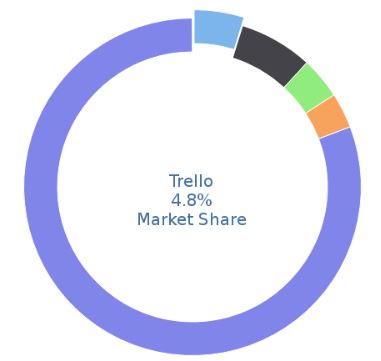
(Source: enlyft.com)
- Trello statistics show that its competitiveness lies in ERP, with a share of 4.8% in the entire ERP market. This means an estimated 5% of the companies that use ERP tools to automate workflows and business processes decided upon Trello as their main tool.
- While Trello is known mainly for project management and collaboration, it is versatile and works with other enterprise software well enough to be somewhat integrated into the company’s ERP ecosystem.
- In the ERP segment, Trello’s major competitors can be really defined as tight-fit ERP platforms that provide more extensive solutions in other areas such as finance, human resource management, supply chain management, and more.
- SAP ERP, Oracle Net Suite, Microsoft Dynamics 365, and Workday are some key competing products in this field.
- Advanced ERP features supporting financial management, inventory tracking, procurement, payroll processing, and other operational needs make these platforms favorable for large corporations.
Trello Usage By Industry
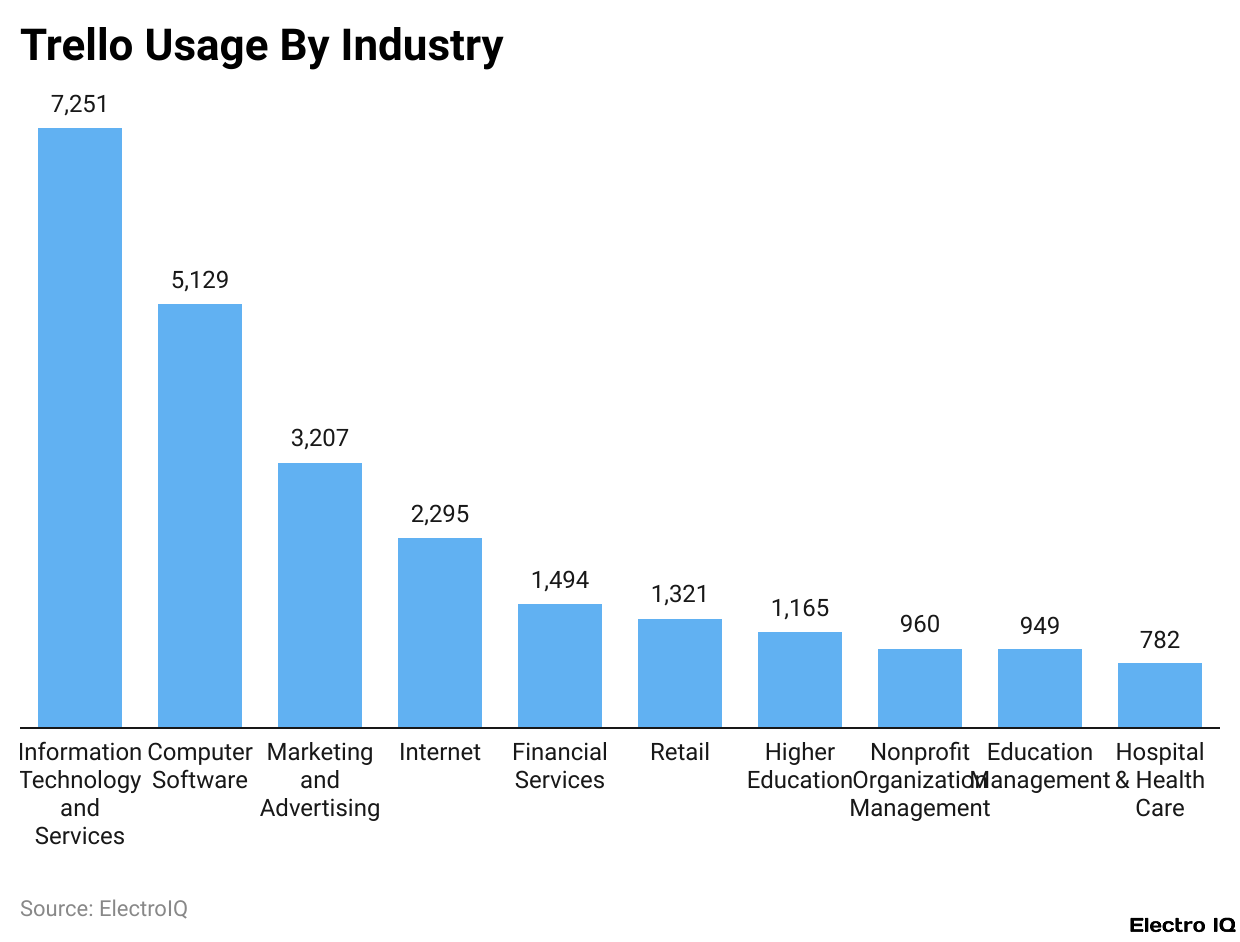
(Reference: enlyft.com)
- Trello statistics indicate that Trello is in use across almost every industry, with Information and Technology Services sitting high on the list with 7,251 companies. Such evidence suggests a preference among IT professionals for using Trello-based project management tools.
- Computer Software is the next industry to have significant adoption levels, with 5,129 firms that have adopted Trello in their project applications, mainly representative of software development teams and technology startups.
- Marketing and advertising firms also use Trello significantly: 3,207 companies have integrated Trello into their workflows. This is likely due to Trello’s ability to ease campaign planning and collaboration efforts.
- The Internet industry, which houses all online companies and e-businesses providing web services, has 2,295 of its companies employing Trello, substantiating its purpose in digital project management. This is followed by Financial Services, where 1,494 firms organise business processes and workflow management of tasks on Trello.
- In total, some 1,321 retail businesses use Trello for inventory, supply chain coordination, and store operations. In the educational field, 1,165 higher education institutions use Trello, which often involves project management in academic work, course organisation, and administrative planning.
- Nonprofit Organizations and Management together make up 960 companies using Trello for event planning, donor management, and internal coordination.
- The Hospital and Health Care domain, which would, therefore, significantly use Trello for coordinating patient care and related admin work, stands at 949.
- Another 782 companies are housed within the larger healthcare industry, which gives credence to the request for Trello for managing hospitals and other medical projects.
Distribution Of Company Use Trello By Country
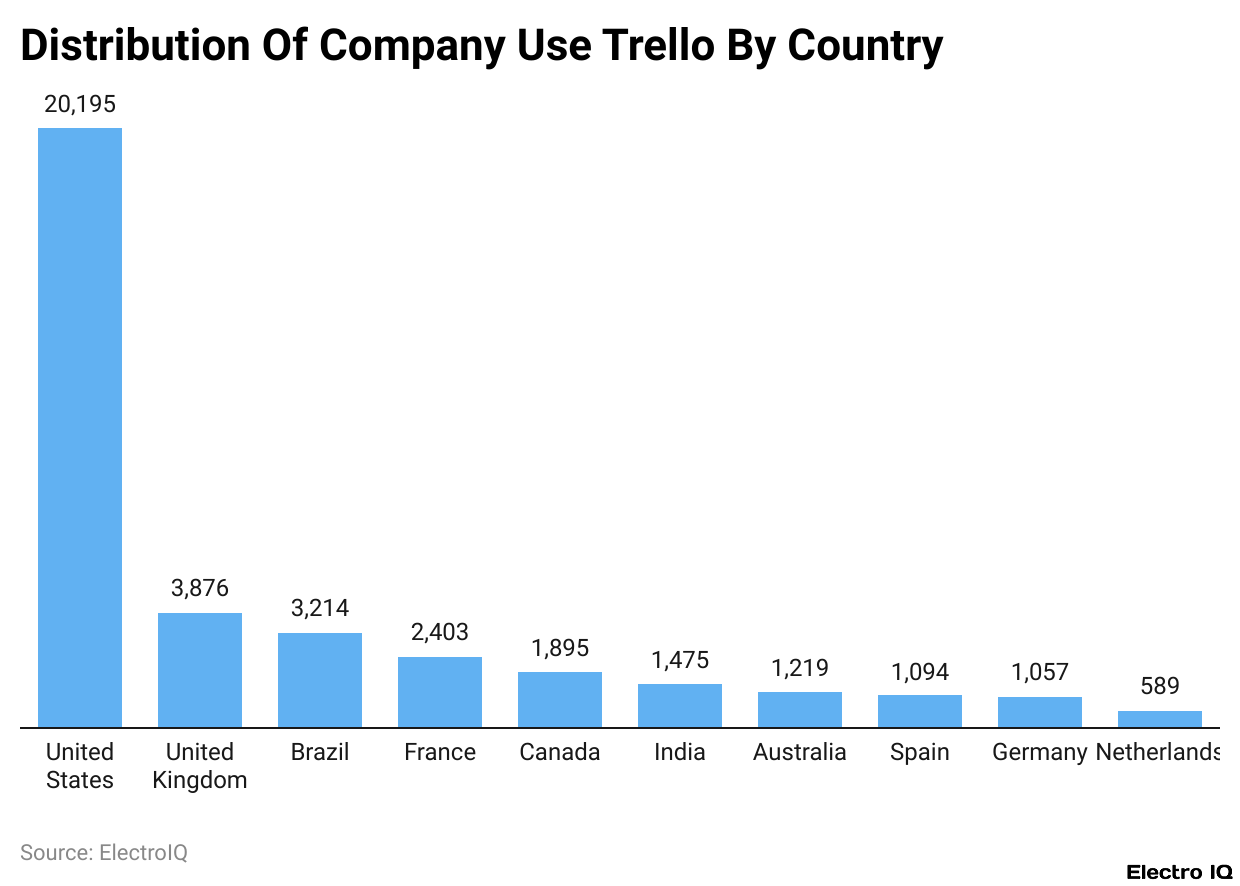
(Reference: enlyft.com)
- Trello statistics state that in the United States, 20,195 companies adopted Trello as their organisational platform.
- With such high adoption rates, Trello has maintained an even presence in English-speaking countries like the United Kingdom, with 3,876 companies.
- Brazil has the next-highest ranking with 3,214 companies that demonstrate Trello’s acceptance within South America.
- In France, 2,403 companies use Trello, while in Canada, the number is 1,895. Thus, Trello has a strong presence in Europe and North America.
- On the other hand, acceptance of Trello within Asia remains robust, given that 1,475 companies from India use it, followed closely by Australia with 1,219. This was followed closely by Spain and Germany, with 1,094 and 1,057 companies, respectively, hinting at a budding adoption in Western Europe.
- The feather on the crown of Trello adoption comes from 589 companies in the Netherlands, still presenting Trello in smaller yet highly technologically developed countries.
- These numbers underline Trello’s very broad geographical spread and reemphasise its pertinence in heterogeneous business contexts worldwide.
Trello Website Visits
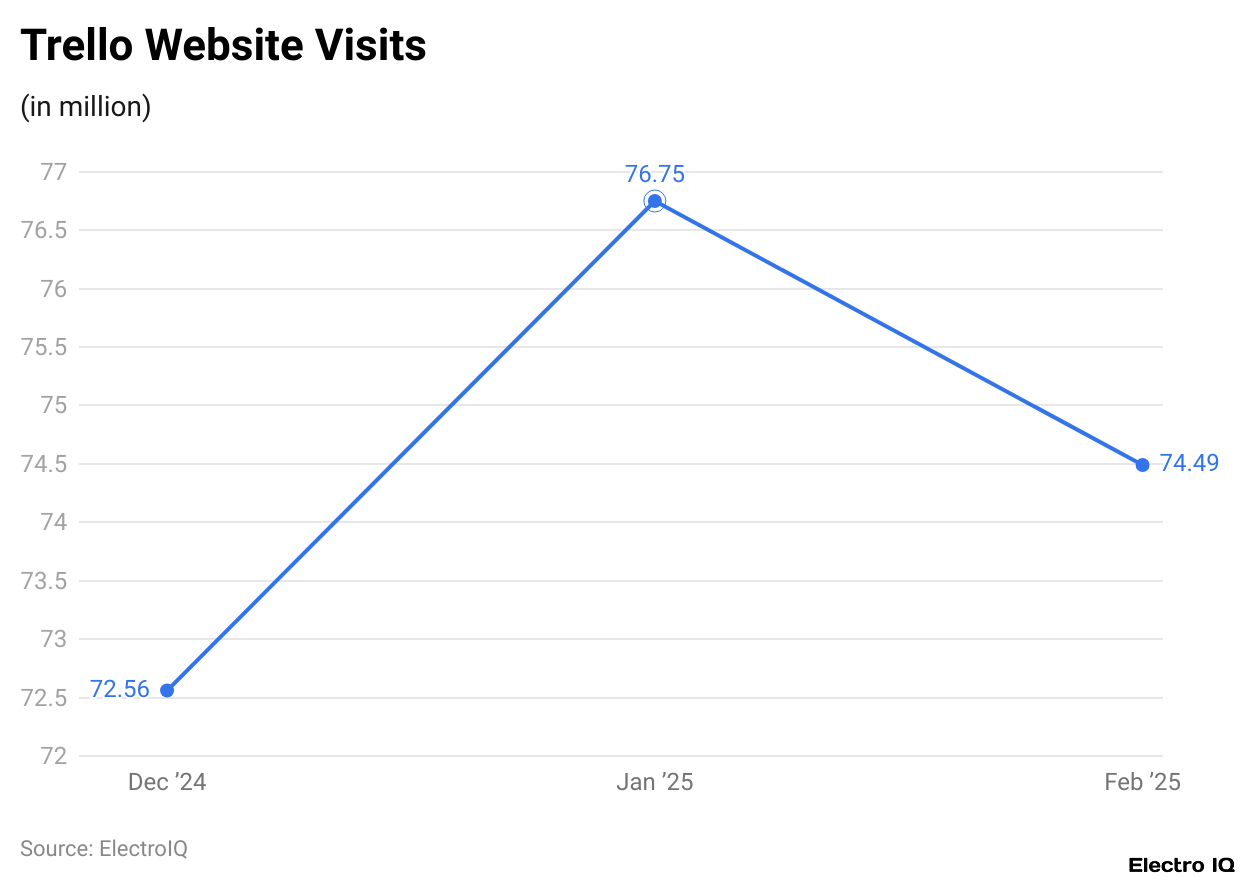
(Reference: similarweb.com)
- According to Trello statistics, the website traffic of Trello posted engagements over the past months. In December 2024, 72.56 million visits were registered on the platform.
- This value recorded an increase in January 2025 to reach 76.75 million, indicating a rise in user activity at the dawn of the year.
- On the contrary, visits in February 2025 suffered a slight drop of 74.49 million; even so, the numbers were higher than the visits in December.
- Observed behavior about usage seems to demonstrate seasonal variations with peak activity in January, which could be expected from corporations and persons initiating new projects for the year.
- Irrespective of the decline in February, overall traffic appears to remain buoyant, further consolidating Trello’s continued acceptance among users.
Trello Website Traffic By Country
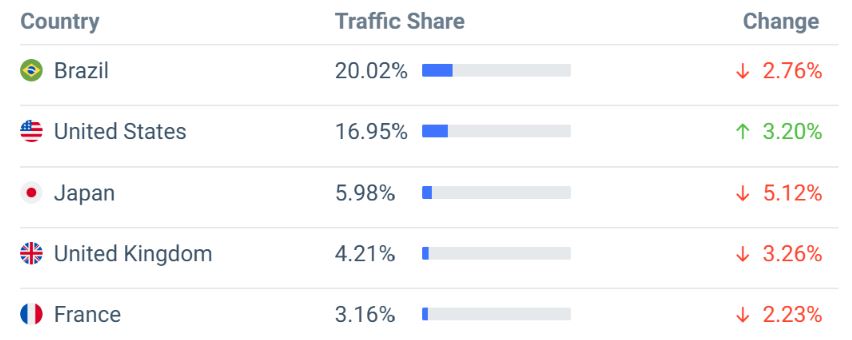
(Source: similarweb.com)
- Trello statistics reveal that Brazil has the largest share, 20.02%, of the distribution of Trello website traffic across several countries.
- However, that percentage of website traffic coming from Brazil has decreased by 2.76%, hinting at a minor decrease in user engagement.
- The United States follows on with a 16.95% traffic share, showing positive inclination with a 3.20% hike, indicating a growing interest or adoption in the region.
- Japan adds 5.98% of visits to the Trello website but has borne the highest fall of 5.12%, indicating declining user retention or a change of preferences.
- In the United Kingdom, 4.21% of traffic came from this source but has also decreased by 3.26%. On the other hand, 3.16% of France has seen declining traffic by 2.23%.
- This pattern indicates that Trello is performing strongly in many markets, while some regions are exhibiting fluctuations in engagement levels, with the U.S. being an emerging growth region.
Trello Marketing Channels

(Source: similarweb.com)
- Trello statistics state that Trello makes most of its traffic directly for marketing purposes-83.47% of all users come to Trello through such. This means a majority of people type the Trello URL, bookmark and come to the Trello site.
- This clearly states that there has been significant brand loyalty and recognition. Organic search contributed 10.78, which, in effect, means that a vast proportion of users visit Trello through search engines rather than considering any paid promotions. It indicates how effective Trello’s SEO strategies and content marketing are.
- Paid marketing is only 1.40%, showing that Trello doesn’t make its mark through paid advertisement. Word of mouth and organic reach have much more significance.
- For example, referral traffic is 3.65%, which means that it comes from external websites linking to it, which shows that some traffic is based on mentions and partnerships with different platforms.
- The contribution of display ads is a minimal one, just 0.03, showing that display ads or other visual promoting mediums are not the primary focusing area.
- It brings in only 0.062% of traffic, indicating that even though Trello uses sites like LinkedIn, Twitter, and Facebook, it relies little on them to tap into new users.
- Email marketing is even lower, at just 0.04; like with social media, this could suggest that Trello does not utilise and prioritise direct email campaigns very much to get users.
- These numbers support the argument that Trello’s success is rooted more in its brand reputation, visibility on search engines, and organic engagement rather than expensive paid advertising.
Trello Demographics

(Source: similarweb.com)
- According to Trello statistics, the Trello demographic scheme gives an almost equal gender division across its 54.52% male users against 45.48 % female users. This means that both genders lean toward using the platform but with a slight difference of more usage by men.
- Most of the age spectrum falls between 25 and 34, accounting for 29.92% of the total users on Trello.
- This shows that Trello’s audience mainly consists of young professionals and people in early-stage careers. The second largest segment is 18 – 24 years, which constitutes 21.67%, indicating that students and younger professionals have a keen inclination to adopt the app.
- Those users aged between 35 to 44 years make an average of 18.62%, while the people between 45 to 54 form 13.77%, emphasising a constant use of the platform amongst professionals who have been trained or have a mid-career position.
- The 55- to 64-year-old demographic contributes about 10.05%, while those aged 65 and older make up only 5.97%. This shows that adoption rates are not very high among older people. In a nutshell, consumers who are using Trello for usage purposes are mostly below 40 years of age.
- The ages mostly represent people in their 20s and 30s, and it also appears to lack increasing usage on age.
- Again, the user base comprises students, professionals, and business users, which shows the flexibility of this platform in both personal and corporate settings.
Conclusion
As per Trello statistics, Trello’s smooth sailing by indication of the healthy and significant entry it continuously creates into the landscape of project management. With the still-incoming new users and appreciable international revenue, and all while enjoying a good footing within professional communities, it still remains a favored choice for very many organisations.
The data breach was a reminder, still, of the need for continuous investment in security measures towards gaining and maintaining trust from users as well as placing integrity in the platform by users.
Sources
FAQ.
4.8% market share in ERP software. Competing majorly with platforms including but not limited to SAP ERP, Oracle NetSuite, and Microsoft Dynamics 365, Trello is chiefly a project management tool but has the capability to act as an adaptable tool and integrate with other resource tools and thus be a true business process management tool.
Out of the total 7,251 companies using Trello in the Information Technology Services sector, the next highest industries include Computer Software with 5,129 companies, Marketing & Advertising with 3,207 companies, and Financial Services, Retail, Healthcare, and Education.
The United States tops the list with an impressive 20,195 Trello users, with the United Kingdom at a distant second with approximately 3,876 users and with Brazil and France trailing behind with 3,214 and 2,403 users, respectively. This clearly shows just how strong the brand capital is in North America, Europe, and South America.
Most of the traffic on the Trello website comes from direct visits (83.47%), indicative of brand loyalty, while 10.78% comes from organic search and 1.40% from paid marketing. Referrals, social media, and email marketing perform at 3.65%, 0.62%, and 0.04%, respectively.
Trello’s users comprise of 54.52% males and 45.48% females, while 29.92% belong to the age group 25-34 years, followed closely by 21.67% with those aged 18-24 years and 18.62% with those aged 35-44 years. The statistics show strong adoption among young and early-career professionals.

Barry Elad is a passionate technology and finance journalist who loves diving deep into various technology and finance topics. He gathers important statistics and facts to help others understand the tech and finance world better. With a keen interest in software, Barry writes about its benefits and how it can improve our daily lives. In his spare time, he enjoys experimenting with healthy recipes, practicing yoga, meditating, or taking nature walks with his child. Barry’s goal is to make complex tech and finance information easy and accessible for everyone.






